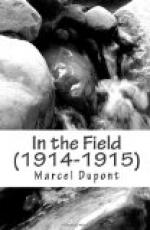“Tell me, child, who burnt that chateau over there?”
“M’sieur, they did; and they took everything away—all the beautiful things. They even carried everything off on big carts, and then they set fire to the house. But everything isn’t burnt, and a lot of them came back again this morning with some horses, and they went on looking for things.”
I sent off another squad towards the chateau, telling them first to follow the edge of the wood and to be careful how they approached it. The men got into the wood by the spaces in the bank along the road and scattered in the thickets that dotted the side of the spur we were turning. I was thus protected on my right.
I went up at a trot to the place where the road reached the plateau, and just as I was on the point of reaching it we were met by a crowd of village folk—men, women, and children—coming along, looking radiant. I saw some of them questioning my advance scouts and pointing in the direction of the north-east. It was the whole population of Le Charmel that had come out to meet us.
Le Charmel is a small village that stands at the meeting of two roads, one leading towards Fismes, the other towards Fere-en-Tardenois. It has the appearance of hanging on to the hillside, for whilst the road to Fere-en-Tardenois continues to follow the plateau, that to Fismes dips abruptly at this place and disappears in the valley. The houses of Le Charmel are perched between these two roads. Thus the people of the village had a good view of the enemy’s retreat, and everybody wanted to have his say about it. I turned to a tall man, lean and tanned, with a grizzled moustache, who had something still of a military air, and seemed to be calmer than the others around him. From him I was able to get some fairly clear information.
“Mon Lieutenant, it was like this.... They went off this morning early, with a great number of cannons and horses. The artillery went straight on towards Fismes by the road. The cavalry cut across the fields, and disappeared over the ridge you see over there on the other side of the valley. Then towards eight o’clock some of them came back. How many? Well, two or three regiments perhaps, and some guns; and they went down again towards Jaulgonne. I believe they wanted to destroy the bridge. But just as they got to the turn of the hill, pan! pan!—they were fired at. Then, of course, we got back to our houses and shut them up, as the guns began to fire. But when we heard no more reports we came out again, and saw them making off across the fields like the others and in the same direction. But it is quite possible that some of them stayed in the woods, or in the farms, on the other side of the forest of Riz....”
He was interrupted by my non-commissioned officer:
“Mon Lieutenant, the scouts ... they are signalling to you....”
I galloped up to them, when they pointed out to me, at about 1,500 yards distance, on the opposite ridge, a small group of cavalrymen near a stack, and, on the side of the slope, a patrol of German dragoons, pacing slowly with lances lowered and stopping every now and then facing in our direction.




